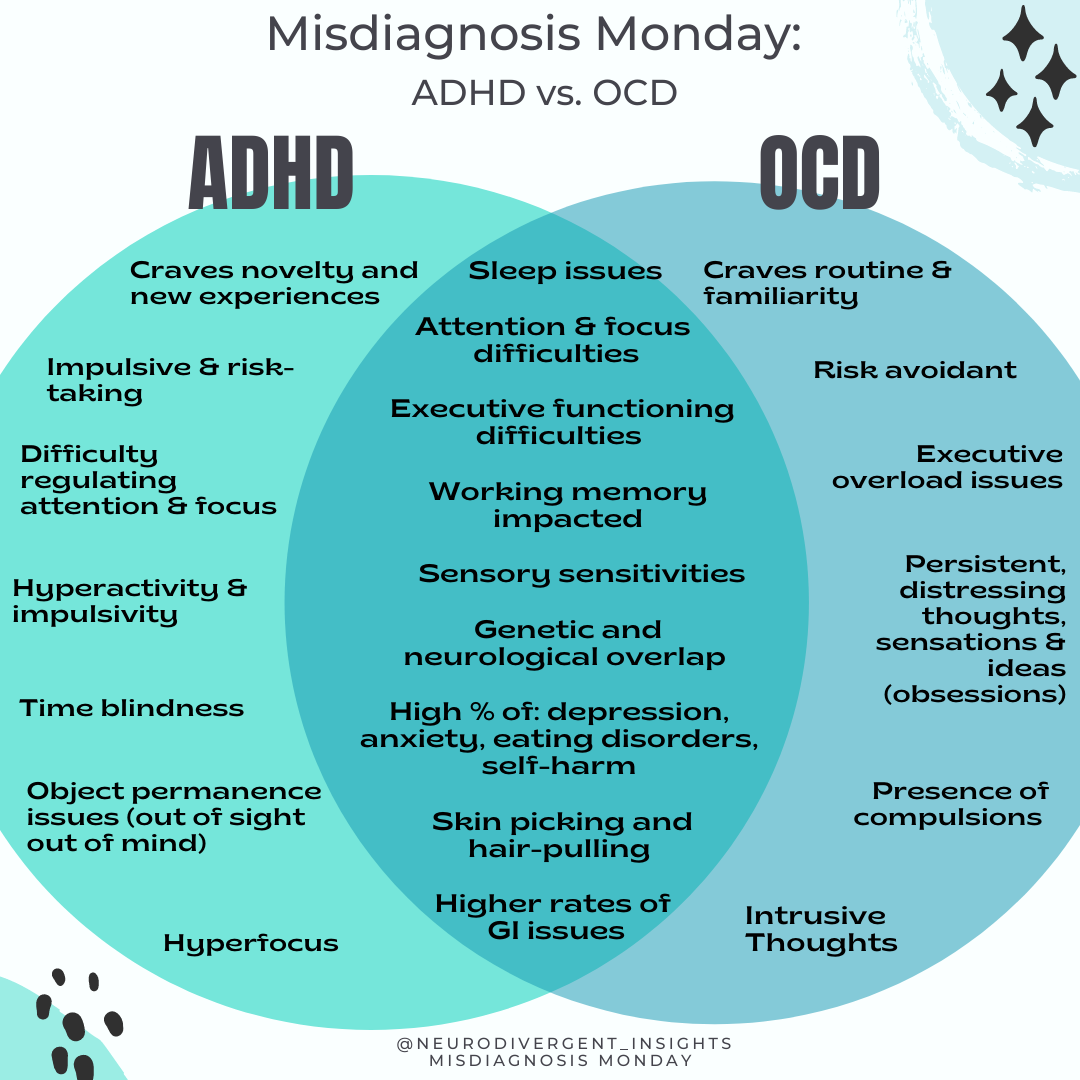🗂️ [[Indices/Sources]]
# ADHD vs OCD
📰 **ADHD and OCD are neurodevelopmental conditions that can sometimes be misdiagnosed as each other due to overlapping symptoms.**
📇 [[Megan Anna Neff]]
🏛️ Neurodivergent Insights
🔗 https://neurodivergentinsights.com/misdiagnosis-monday/adhd-vs-ocd

> [!check] Finished Reading
>**Last read**: Wednesday, 22 May 2024
>**My rating**: 10 out of 10
> _Has provided great clarity on the intersection between these diagnoses._
>[!abstract]
> `= this.abstract`
🔑 [[obsessive-compulsive disorder (OCD)|OCD]], [[ADHD|ADHD]]
[[Megan Anna Neff - ADHD vs OCD|👉🏼]] `= this.author` (`= this.publishDate`). *`= this.title`*. `= this.publisher`. `= this.url`
%%
## 📝 Notes
## 📃 Selected Quotes
## 📋 Table of Contents
## 📖 Annotations
%%
#
**Template**: [[Book Search Template]]
**Created**: [[2024-05-22|Wednesday 22 May 2024]]
**Published**: [[2022-11-05|Saturday 05 November 2022]]
**Updated**: 09:58 [[2024-05-22|Wednesday 22 May 2024]]
## Readwise Highlights and Notes
### Imported from [[Readwise]] on [[2024-05-22]]
 ([[Megan Anna Neff - ADHD vs OCD|Neff, 5 November 2022]], [View Highlight](https://read.readwise.io/read/01hyed54eessas5fpqdd50a9k8)) ^8ed2a2
They co-occur at high rates. When one is present, it can be difficult to spot the other. At times ADHD may be misdiagnosed as OCD, or OCD may be misdiagnosed as ADHD, or one is diagnosed while the other remains missed. ([View Highlight](https://read.readwise.io/read/01hyed5g5razm3p62v7mmqj4vd)) ^f493a3
Interestingly, they appear as opposite conditions in some ways as these conditions lay at opposite ends of the impulsive-compulsive continuum. And so, the co-occurrence of these conditions is a perplexing phenomenon. Furthermore, although these conditions are distinct, they also share several overlapping traits, making them difficult to distinguish. ([View Highlight](https://read.readwise.io/read/01hyed5h692tny8aspxa0cgp3d)) ^295025
ADHD is classified as a neurodevelopment condition, meaning the onset occurs during the developmental period (typically early childhood) and has a strong genetic component. ([View Highlight](https://read.readwise.io/read/01hyed5yxr3n24vhvrk6mxepjc))
OCD is the world’s fourth most common psychiatric disorder. There is a lifetime prevalence of 2–3%. OCD symptoms typically emerge during childhood or adolescence. ([View Highlight](https://read.readwise.io/read/01hyed6d81yscnrvf8x7rst5zc))
Symptoms often first appear in childhood, and typically peak around age 11 and in early adulthood. People with OCD commonly have co-occurring psychiatric conditions, ADHD being one of the most common co-occurring conditions ([Brem et al., 2014](https://www.ncbi.nlm.nih.gov/pmc/articles/PMC4148591/#CR107)). ([View Highlight](https://read.readwise.io/read/01hyed6fzzkw920tvh5s39nmhn))
Obsessions are characterized by recurrent, intrusive, and distressing thoughts. These thoughts often create anxiety, at which point the person often engages in compulsions (rituals or behaviors) which function to “neutralize” the anxiety associated with the obsessive thoughts. To meet the criteria for OCD, these thoughts must be excessive and distressing. ([[Megan Anna Neff - ADHD vs OCD|Neff, 5 November 2022]], [View Highlight](https://read.readwise.io/read/01hyecmhe45n70dq0q9zqsav87))
To meet the criteria for OCD, these thoughts must be excessive and distressing. ([[Megan Anna Neff - ADHD vs OCD|Neff, 5 November 2022]], [View Highlight](https://read.readwise.io/read/01hyecmhe45n70dq0q9zqsav87)) ^f666a3
Obsessive and intrusive thoughts tend to cluster around similar themes. Some common obsessions include:
• Fear of contamination
• Worries about having left appliances on or doors unlocked
• Fear of acting in shameful or humiliating ways
• Discomfort with things being out of order
• Sexual imagery
• Hypochondriac and health anxiety
• Excessive thoughts regarding religion/guilt/shame and purity
([[Megan Anna Neff - ADHD vs OCD|Neff, 5 November 2022]], [View Highlight](https://read.readwise.io/read/01hyed76ea79nty4dawm8qf338))
^64cf7c
Some common compulsions include:
• Excessive cleaning and handwashing,
• Repeating checking doors, locks, appliances
• Rituals designed to ward off contact with superstitious objects
• Arranging and rearranging objects
• Using prayers or chants to prevent bad things from happening
• Hoarding
Source [Brem et al., 2014](https://www.ncbi.nlm.nih.gov/pmc/articles/PMC4148591/) ([[Megan Anna Neff - ADHD vs OCD|Neff, 5 November 2022]], [View Highlight](https://read.readwise.io/read/01hyed7fddgyfw6hjs4yjqdbq5)) ^e6a8a5
Both conditions are classified as neurodevelopmental disorders with onset in childhood, share genetic overlap, and co-occur at high rates. ([View Highlight](https://read.readwise.io/read/01hyed8ee6rxxrma0vh3je375a))
In the context of OCD, a person may struggle with attention regulation for different reasons. A person can become preoccupied with obsessions or completing rituals which makes it difficult to focus and pay attention to the task at hand or the person speaking. ([View Highlight](https://read.readwise.io/read/01hyecnqw3kraht81a1rq651bw))
While skin-picking and hair-pulling are typically associated with OCD and classified as an obsessive and compulsive-related disorder, it can also occur in the context of ADHD. Skin-picking, hair-pulling, and nail-biting may be related to anxiety, sensory stimulation, and impulsivity. ([View Highlight](https://read.readwise.io/read/01hyecnx71yyrnjk0sxypyrq92))
Both groups have elevated rates of disordered eating and eating disorders. Body dysmorphia and eating disorders are associated with OCD. In one study of 237 females with eating disorders (84 with anorexia and 153 will develop bulimia), 29.5% had OCD. And OCD was associated with having a long history of eating disorders ([Milos et al., 2002](https://onlinelibrary.wiley.com/doi/abs/10.1002/eat.10013)). OCD rates were similar among people with anorexia and bulimia. ([View Highlight](https://read.readwise.io/read/01hyecphvaksx9cjh140cm5wt0))
Executive overload occurs when a person’s brain is overwhelmed with intrusive thoughts; their executive functioning becomes so taxed (with the thoughts and with potential internalized rituals or compulsions to respond to these thoughts) that their executive functioning becomes overloaded, leaving the person with limited capacity to focus and direct their attention to their external environment. it is difficult for the person to attend to details, focus and pay attention. ([View Highlight](https://read.readwise.io/read/01hyecq01emjc7w3nf4wn10jqz))
While perhaps less common, a person with ADHD may be misdiagnosed with OCD. A person may develop sophisticated compensatory strategies to offset their attention and focus difficulties. For example, a person may become obsessively particular about their external environment (to manage focus issues). ([View Highlight](https://read.readwise.io/read/01hyecqq89b95wp23fay5n41eb))